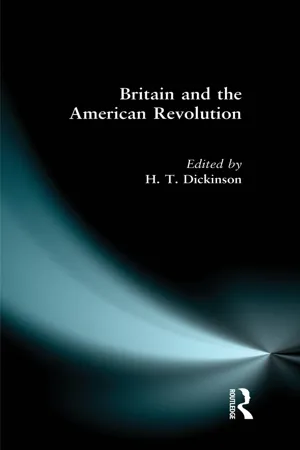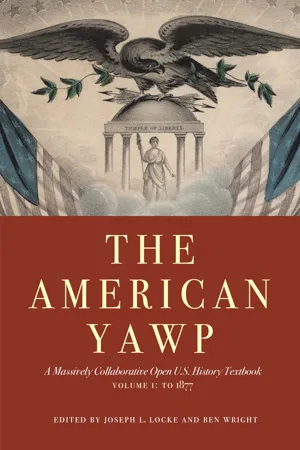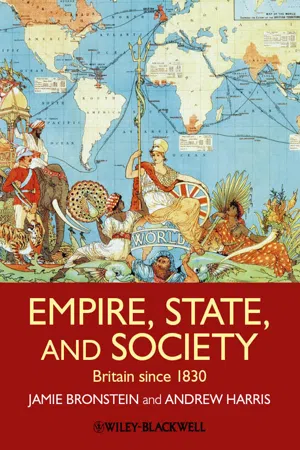History
British America
British America refers to the colonies and territories in North America that were under British rule from the 17th to the 19th centuries. These territories included present-day Canada, the eastern United States, and parts of the Caribbean. British America played a significant role in the expansion of the British Empire and the development of transatlantic trade and commerce.
Written by Perlego with AI-assistance
Related key terms
5 Key excerpts on "British America"
- eBook - ePub
Britain since 1688
A Nation in the World
- Stephanie Barczewski, John Eglin, Stephen Heathorn, Michael Silvestri, Michelle Tusan(Authors)
- 2014(Publication Date)
- Routledge(Publisher)
Yet it is the case that the Second British Empire encompassed new lands and engendered new ideas about how the British ought to govern their overseas territories. In general, the lesson that Britain’s political leaders drew from the American Revolution was that their governance of the North American colonies had been too lenient. More authoritarian forms of government were thus developed. In Canada, for example, when colonial legislatures were established for Upper (Anglophone) and Lower (Francophone) Canada, they were made subordinate to a colonial governor appointed by Britain. In India, the military conquests of the East India Company continued into the early decades of the nineteenth century. The conquest of India raised major questions about the conflict between colonial expansion and British pride in the nation’s commitment to liberty for all its subjects, at home and overseas. “Plantation colonies” like those in North America and, later, Australia and New Zealand, were based upon the premise that British settlers would assume authority over a small, primitive, and therefore insignificant indigenous population, and were therefore easily envisioned as replica Britains in miniature. The British used the legal doctrine of terra nullius, which claimed that human beings had a right to territory that was not being properly utilized, to justify their encroachment upon these lands. Imperial expansion into Asia, however, required Britons to confront large populations and civilizations with very different social, cultural, and political attitudes and institutions from their own. In India, territorial control required conquest of the alien but obviously sophisticated Mughal empire, which occupied a land that was far from “empty.” This reality was difficult to reconcile with the contemporary belief that empires won by way of conquest would lead to a loss of political liberty not just for the conquered but for the conqueror - eBook - ePub
- H. T. Dickinson(Author)
- 2014(Publication Date)
- Routledge(Publisher)
Britain and the Administration of the American Colonies KEITH MASONThe closing years of the Seven Years War (1756-63) saw Britain's imperial star at its zenith. An impressive run of successes at home and abroad culminated in the Treaty of Paris of 1763, which ratified British possession of a vast new global empire. In North America alone, according to its terms, Britain formally acquired not only Canada, but all the French colonies east of the Mississippi river together with Spanish Florida. These acquisitions were greeted with joy both in the metropolis and in Britain's North American colonies. Benjamin Franklin, for instance, was convinced that the peace was 'the most advantageous for the British nation ... of any your annals have recorded'. With the acquisition of Canada, in particular, a glorious destiny seemed to await the inhabitants of the newly expanded British empire regardless of which side of the Adantic they resided. '[A]ll the Country from St. Laurence to Missis[s]ip[p]i', Franklin declared, 'will in another Century be fill'd with British People; Britain itself will become vastiy more populous by the immense Increase of its Commerce; the Atlantic Sea will be cover'd with your Trading Ships; and your naval Power thence continually increasing, will extend your Influence round the whole Globe, and awe the World!' These reflections even led him to claim that 'the Foundations of the future Grandeur and Stability of the British Empire' now lay in America.11. Quoted in Esmond Wright, Franklin of Philadelphia (Cambridge, MA, 1986), p. 123.Franklin's boast was soon to sound rather hollow, however, for British military success brought in its wake a host of thorny administrative problems that were as much a product of the recent conflict as his optimism. How, for example, should the imperial government handle the defence and government of its newly acquired possessions? What provisions should the authorities make for the settlement of western lands? How could they contain an unprecedented national debt of almost £140 million and still shoulder their new responsibilities? And the trickiest problem of all, as it happened: what contribution should the colonies make to all of this? Taken by themselves, these issues were potentially explosive. Their impact was significantly greater, however, because they fuelled festering resentments on both sides of the Atlantic over the imperial-colonial relationship. In fact, by gaining Canada, the government ironically set in motion a train of events that would end twenty years later with the loss of the rest of British North America. Through an examination of the earlier course of imperial-colonial relations as well as an analysis of the impact that the Seven Years War had upon their dynamics, this chapter explores the reasons why the high hopes expressed by Franklin and others evaporated so quickly. - eBook - ePub
The American Yawp
A Massively Collaborative Open U.S. History Textbook, Vol. 1: To 1877
- Joseph L. Locke, Ben Wright(Authors)
- 2019(Publication Date)
- Stanford University Press(Publisher)
3 British North AmericaI. IntroductionUnidentified artist, The Old Plantation , c. 1790–1800, Abby Aldrich Rockefeller Folk Art Museum. Wikimedia.Whether they came as servants, slaves, free farmers, religious refugees, or powerful planters, the men and women of the American colonies created new worlds. Native Americans saw fledgling settlements grow into unstoppable beachheads of vast new populations that increasingly monopolized resources and remade the land into something else entirely. Meanwhile, as colonial societies developed in the seventeenth and eighteenth centuries, fluid labor arrangements and racial categories solidified into the race-based, chattel slavery that increasingly defined the economy of the British Empire. The North American mainland originally occupied a small and marginal place in that broad empire, as even the output of its most prosperous colonies paled before the tremendous wealth of Caribbean sugar islands. And yet the colonial backwaters on the North American mainland, ignored by many imperial officials, were nevertheless deeply tied into these larger Atlantic networks. A new and increasingly complex Atlantic World connected the continents of Europe, Africa, and the Americas.Events across the ocean continued to influence the lives of American colonists. Civil war, religious conflict, and nation building transformed seventeenth-century Britain and remade societies on both sides of the ocean. At the same time, colonial settlements grew and matured, developing into powerful societies capable of warring against Native Americans and subduing internal upheaval. Patterns and systems established during the colonial era would continue to shape American society for centuries. And none, perhaps, would be as brutal and destructive as the institution of slavery.II. Slavery and the Making of Race - eBook - ePub
Empire, State, and Society
Britain since 1830
- Jamie L. Bronstein, Andrew T. Harris(Authors)
- 2011(Publication Date)
- Wiley-Blackwell(Publisher)
Britain was more than just a disorganized collection of ancient nationalities and local governing bodies held together by a few strands of central government. It was also the center of an empire, and this had profound implications for its trade, its politics, its identity, and its culture. Even after the loss of the American colonies, Britain remained at war's end in 1815 the greatest imperial power in the world. Imperial concerns had played an increasing role in drawing Britain into military and naval conflicts throughout the eighteenth century, as imperial commercial connections came to be seen as more and more important and worth fighting for. Throughout the eighteenth century, Parliament, newspapers, magazines and public commentary focused on imperial topics: trade, war, governance, imperial architecture and foodways, and the racial, cultural and ethnic difference of “natives” everywhere.But the term “empire” meant not a single kind of colony, a uniform system of governance, or even similar motives for acquiring and developing different plots of land. It did not mean in this period that all imperial subjects spoke the same language or received the same attention from London. The defining feature of the empire was its variability. There were the colonies of primarily white settlement: British North America, and later Canada; Cape Colony; and the colonies that would later combine to form Australia. There was the collection of states, governed partly by the British government and partly by the privately owned East India Company, that would become India. And there were acquisitions through previous centuries’ war and piracy in the West Indies, the Caribbean islands dedicated to agricultural production through slave labor: Jamaica, Barbados, Trinidad and Tobago, and numerous smaller islands.Colonies provided significant amounts of some goods, usually raw materials; but they also provided Britain with the financial and shipping resources to do business in other parts of the world. Of the ten largest British imports in the late eighteenth century, half were from Europe and only three were colonial in origin: sugar (primarily from the West Indies), raw cotton (also primarily from the West Indies in this period), and manufactured cotton and silks (from India – though this was changing rapidly). Fifty years later, Britain still imported most of its second largest import, sugar, from the West Indies, but its largest import, cotton, now came from the United States. Another significant import was timber, one-third of which came from British North America, primarily Canada. Some 30 percent of British exports went to colonial possessions in the first half of the nineteenth century, primarily to the West Indies but also significantly to Canada and India. Britain also did a large export business with the former American colonies, and with Latin America, which had never been part of the British colonial sphere. - eBook - ePub
Why War
Capitalism and the Nation-State
- Simon Stander(Author)
- 2014(Publication Date)
- Bloomsbury Academic(Publisher)
The very word America has been hijacked by the nation-state of the USA and by its inhabitants. Other Americans, those of Meso- and South America, are, generally speaking, partially resigned to this and partially infuriated, substituting Latin America, a term introduced at the time of the French occupation of Mexico, for the numerous nation-states and variety of peoples in these geographical areas (Bender, 2006, p. 120). But the use of the descriptive expression ‘Latin America’ is an admission of a repressive colonial past and does not adequately give sufficient recognition to the Native-Americans of Meso- and South America or to those of the Caribbean. In my several years of living and working in Central America, I found terminologies differed a great deal within these countries from those one heard, say, in Europe or the USA. In Central America, a person from the USA was (rightly) described as a United Statesian (i.e estadounidensis). In Mexico a person from the USA (when not described as a gringa or gringo) is referred to as a Norte-Americano or Norte-Americana because the country we usually know as Mexico is in fact the United States of Mexico, and so anyone from the USA cannot be described as a ‘United Statesian’. Being referred to as a North American, meaning someone from the USA, however, tends to infuriate Canadians who, when the technicality is resolved, may be referred to as Canadiensis. These linguistic distinctions are not mere curiosities. The point is that the original Europeans, mainly British, colonists who settled on the eastern seaboard of the North American continent developed after the War of American [sic] Independence, a pan-colonial vision of both territorial and economic and strategic domination stretching from the original 13 colonies to include the whole of the continents of North and South America.This chapter draws the distinction, then, between the capitalist economy of the USA and its territorially and expansionist policies, and a ‘Latin America’ which was defined by imperial and dynastic but capitalistically backward Spain and Portugal. The capital/nation-state history of the USA has defined the differences between the two geographical expanses of the Americas and has enabled the domination of the one by the other. The USA from its birth has combined its capitalist development with expanding its territorial frontiers. These territorial limits (or limitlessness) have been determined by the extent to which the State of the USA was able to impose its imperial desires on the other European nations, with claims to various land areas of the northern Americas, especially Meso- and South America.The continental imperativeWhile there were a number of causes for the 13 colonies to part company with the colonial power of Britain, the major presenting cause was the need to pay taxes for the defence of the colonies (and their expansion) against the threats of the aboriginal populations and the French. This meant in fact that at the moment of the inception of the USA, it was an imperialist power simply taking on the British mantle. As Gareth Stedman Jones writes: ‘The United States [of America] was already structurally an imperialist state at the moment of its foundation.’1
Learn about this page
Index pages curate the most relevant extracts from our library of academic textbooks. They’ve been created using an in-house natural language model (NLM), each adding context and meaning to key research topics.




